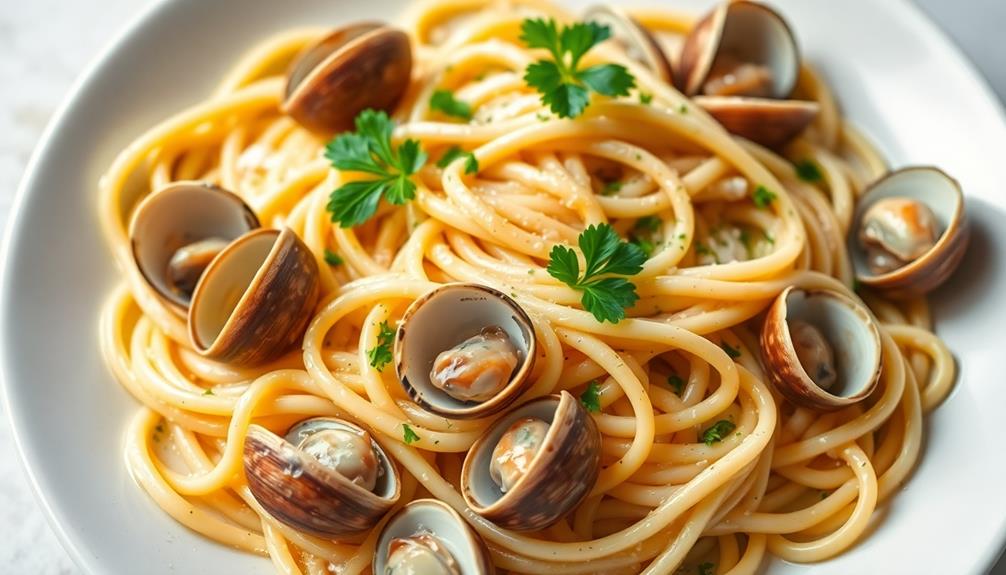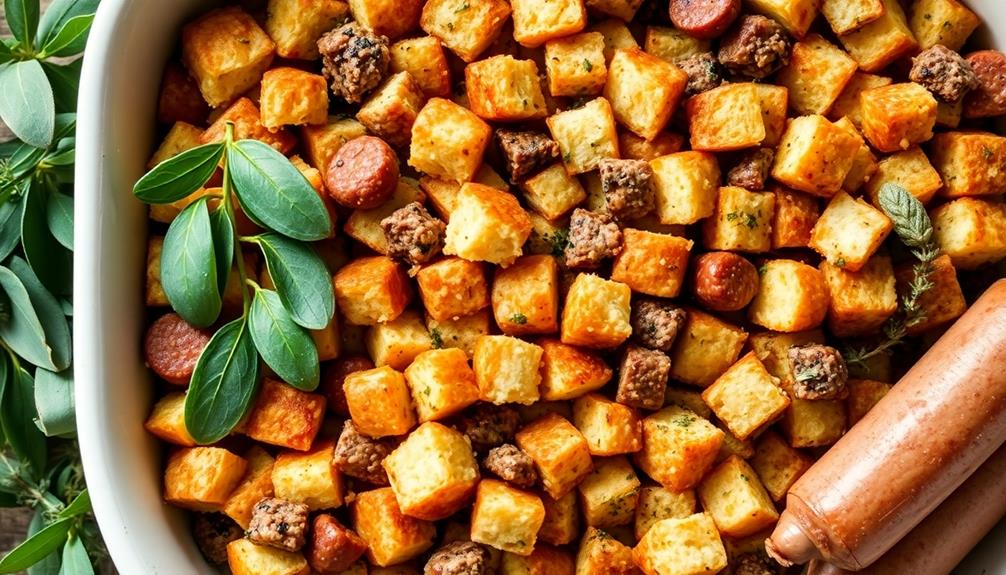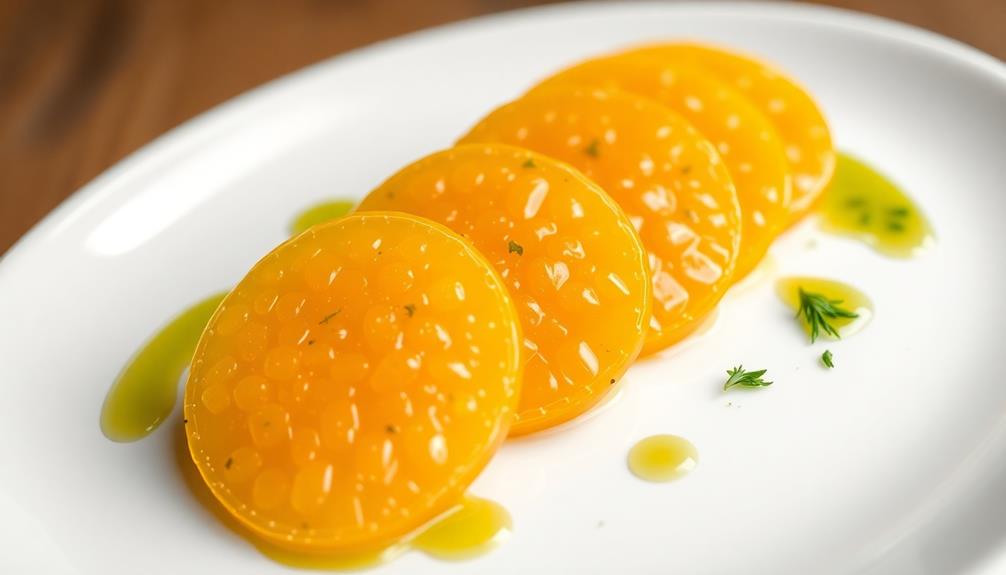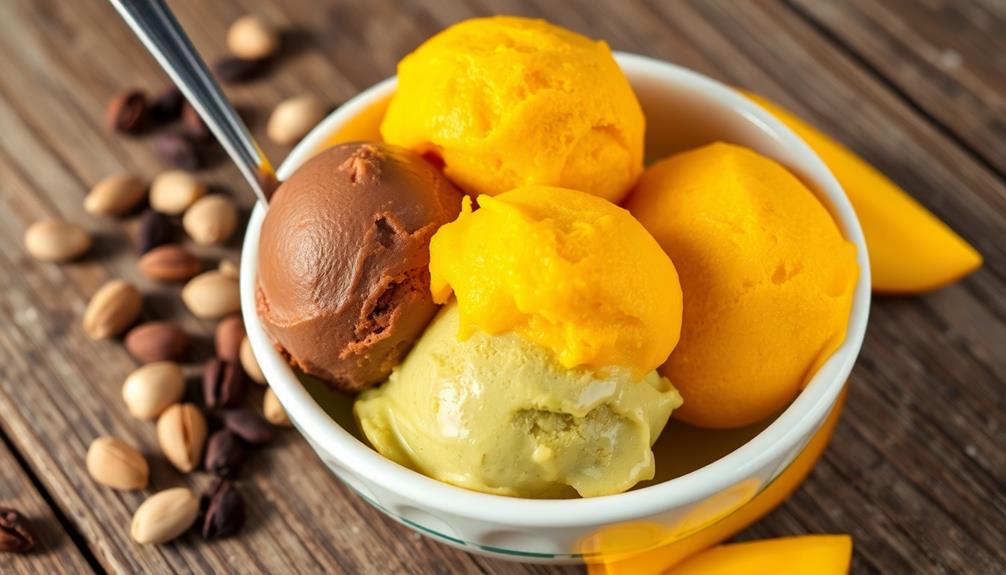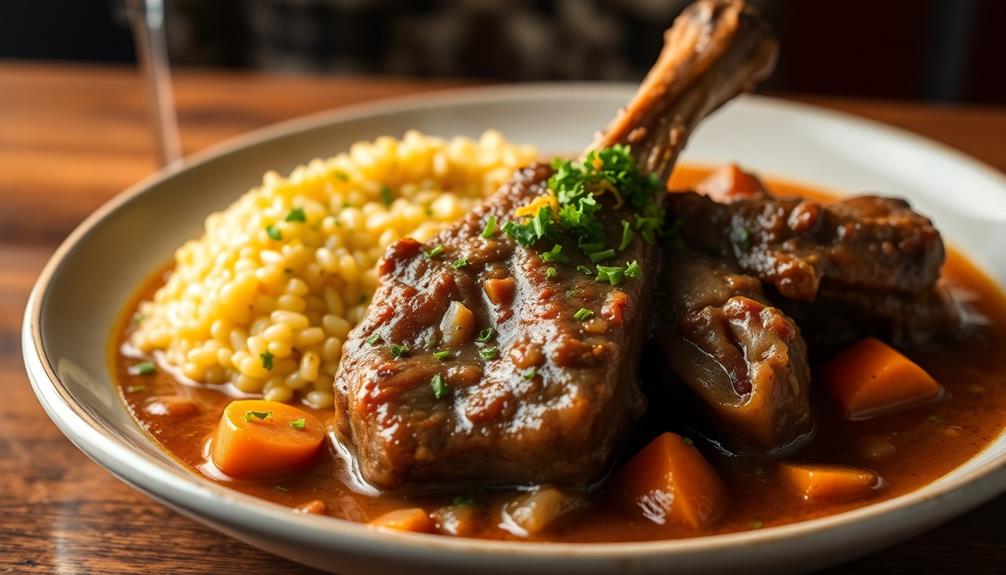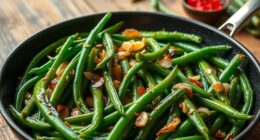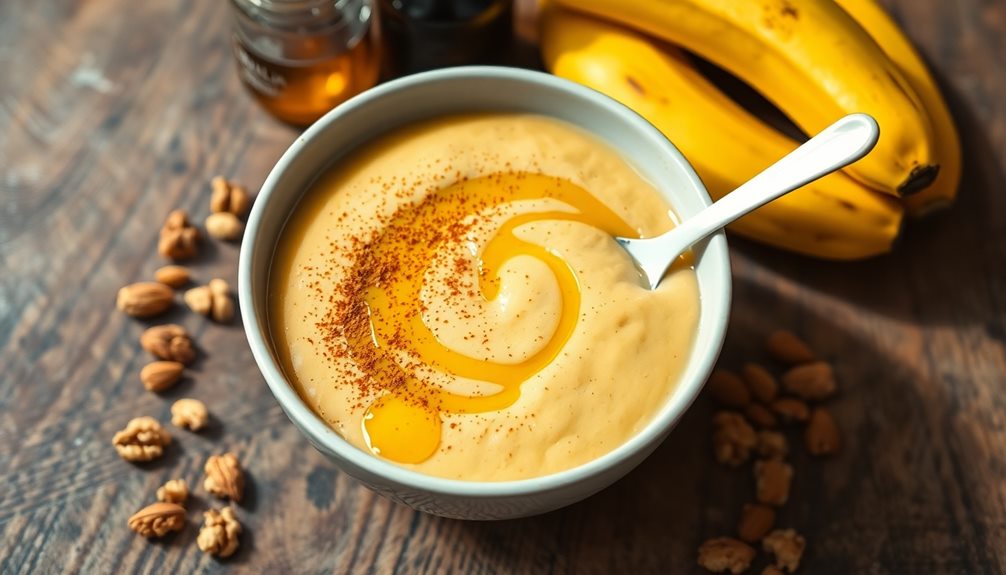You'll love linguine with clams – it's a classic Italian dish that's bursting with coastal flavor! This beloved seafood pasta has a storied history, originating in places like the sun-drenched Amalfi Coast. To make it perfectly, you'll need the freshest ingredients, especially those sweet and briny clams. Once you've gathered everything, the cooking process is straightforward: sauté garlic, cook the clams in white wine, then toss it all with linguine and parsley. It's a simple yet spectacular meal that captures the joy of Italian family dining. And if you'd like to learn even more…
Key Takeaways
- Linguine with Clams is a classic Italian seafood dish originating from coastal regions like the Amalfi Coast and Liguria.
- The recipe calls for fresh clams, linguine pasta, garlic, white wine, olive oil, and parsley to create a flavorful, balanced dish.
- Proper preparation techniques, such as rinsing and soaking the clams, are essential for removing impurities and ensuring a high-quality result.
- Serving suggestions include pairing with a crisp white wine, crusty bread, and a light salad for a complete Italian-inspired meal.
- Linguine with Clams is a beloved staple of Italian cuisine that represents the country's culinary traditions and the joy of communal dining.
History
According to culinary historians, linguine with clams has its origins in the coastal regions of Italy. This beloved dish has been a staple of Italian cuisine for centuries, passed down through generations and enjoyed by families far and wide.
The use of linguine, a long, thin pasta, perfectly complements the briny flavor of the fresh clams. This combination is thought to have first emerged in the seaside towns of the Amalfi Coast and Liguria, where local fishermen would bring in their daily catch to be enjoyed by the community.
Over time, the recipe evolved, with the addition of garlic, white wine, and parsley – ingredients that now define the classic linguine alle vongole.
Today, this vibrant and flavorful dish remains a beloved part of Italian culture, bringing families together around the table to savor the tastes of the sea.
Recipe
Linguine with Clams is a classic Italian seafood dish that combines the delicate flavors of fresh clams with the heartiness of pasta. This recipe is a delightful way to bring the taste of the Mediterranean to your own kitchen.
The key to a successful Linguine with Clams is to use the freshest ingredients possible. Opt for littleneck or manila clams, which will provide a sweet and briny taste that complements the pasta perfectly. Additionally, the quality of the linguine you choose can make a significant difference in the overall dish.
- 1 lb linguine
- 2 lbs littleneck or manila clams, scrubbed
- 4 cloves garlic, minced
- 1/4 cup dry white wine
- 2 tablespoons olive oil
- 2 tablespoons unsalted butter
- 1/4 cup chopped fresh parsley
- Salt and freshly ground black pepper to taste
In a large pot, bring salted water to a boil. Add the linguine and cook according to the package instructions until al dente. Drain the pasta and set aside.
In a large skillet, heat the olive oil over medium-high heat. Add the garlic and sauté until fragrant, about 1 minute. Add the clams and white wine, cover the skillet, and cook until the clams have opened, about 5-7 minutes. Discard any clams that don't open.
Add the cooked linguine, butter, and parsley to the skillet, and toss to combine. Season with salt and pepper to taste.
To ensure the best results, it's important to use fresh clams and to not overcook them. Additionally, be sure to thoroughly clean the clams before cooking to remove any grit or sand.
Serve the Linguine with Clams immediately, as it's best enjoyed hot and fresh from the stove.
Cooking Steps
Rinse the clams thoroughly to remove any grit or sand.
Once they're nice and clean, drain and dry the clams completely.
Next, sauté the garlic in some olive oil until it's fragrant and golden.
Then, add the clams right to that garlicky oil and pour in a splash of white wine.
Let the clams simmer until they've all opened up – that's how you'll know they're ready!
Step 1. Rinse Clams Thoroughly

Before you begin cooking, it's crucial to thoroughly rinse the clams. This important step helps remove any dirt, sand, or grit that may be lingering on the shells.
Gently place the clams in a colander and run cool water over them, gently scrubbing each one with your fingers. Be sure to discard any clams with cracked or open shells, as they may be spoiled.
Next, fill a large bowl with cold water and add the rinsed clams. Let them soak for about 20 minutes. This allows the clams to purge any remaining impurities.
After the soak, give the clams one final rinse under cool running water.
Now your clams are ready to be cooked! The briny flavor of the freshly rinsed clams will pair perfectly with the linguine, creating a delightful seafood dish that's sure to impress your family and friends.
Get ready to enjoy the delicious taste of Linguine Alle Vongole!
Step 2. Drain and Dry Clams Thoroughly
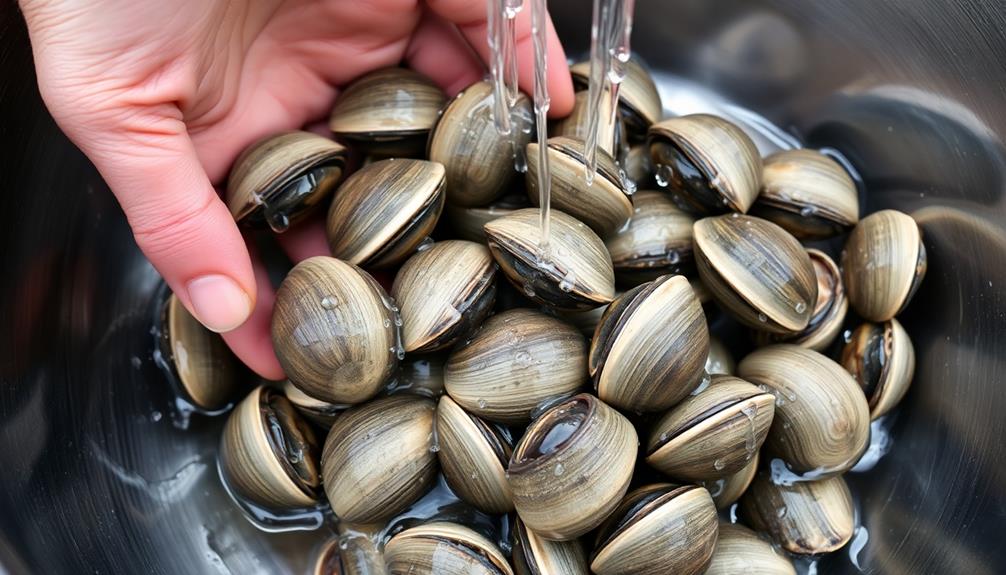
After thoroughly rinsing the clams, you'll want to drain and dry them completely. This step is crucial to ensure the clams don't release too much liquid during cooking, which could make your sauce watery.
Grab a colander or mesh strainer and carefully pour the clams into it, letting the water drain away. Gently shake the colander to help the process along.
Once the clams are drained, transfer them to a clean kitchen towel or paper towels. Spread them out in a single layer and pat them dry with the towels. Make sure to get rid of any excess moisture – you want the clams to be as dry as possible before adding them to the pan.
This extra step may take a little time, but it's worth it to get the perfect texture and flavor in your Linguine Alle Vongole.
With the clams thoroughly drained and dried, you're ready to start cooking up an authentic Italian feast!
Step 3. Sauté Garlic in Olive Oil
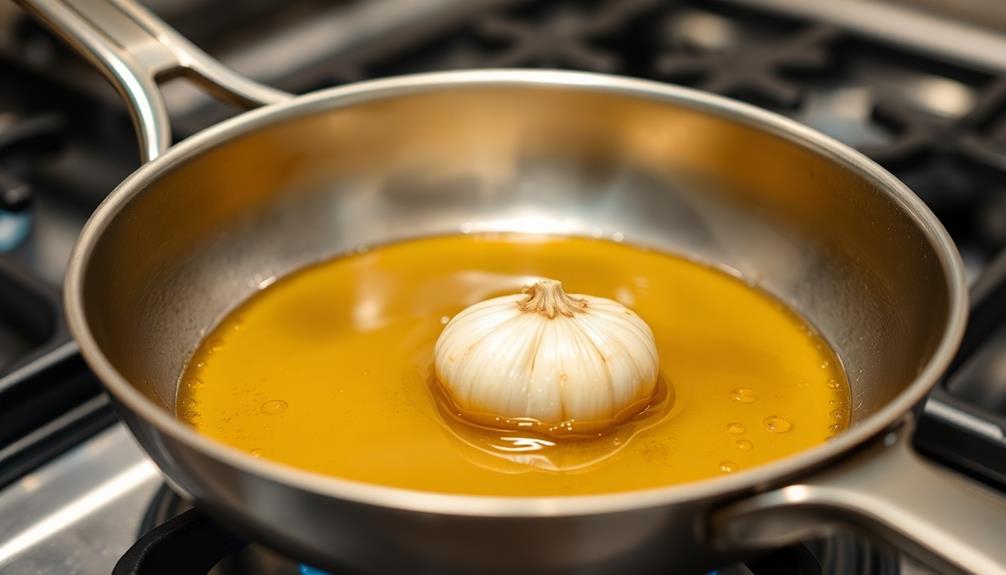
Next, heat a generous drizzle of olive oil in a large skillet or sauté pan over medium heat.
Once the oil is shimmering, add the minced garlic. Sauté the garlic, stirring constantly, until it's fragrant and just starting to turn golden, about 1-2 minutes.
Be careful not to let the garlic burn, as that would give it a bitter taste.
Now that the garlic is perfectly sautéed, it's time to add the drained and dried clams to the pan.
Toss the clams with the garlicky oil, allowing them to sizzle and release their briny juices.
As the clams cook, they'll open up, signaling they're ready to be enjoyed.
Adjust the heat as needed to prevent the garlic from browning too quickly.
This quick sauté helps infuse the clams with the delicious garlic flavor, preparing them for the next step in our linguine alle vongole adventure.
Step 4. Add Clams to Garlic Oil
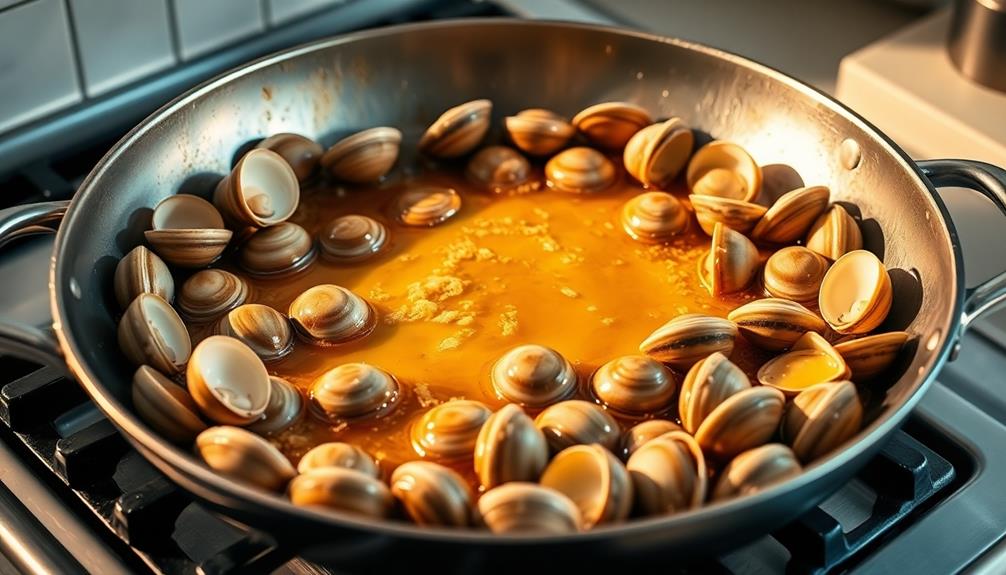
With the garlic fragrant and shimmering in the oil, add the drained and dried clams to the pan.
Listen as they sizzle and pop – that's the sound of dinner coming together! Gently stir the clams into the garlicky oil, coating them evenly. The briny aroma will fill your kitchen, making your mouth water in anticipation.
As the clams heat through, some of their juices will begin to release. This natural liquid gold will mingle with the olive oil, creating a simple but heavenly sauce.
Keep an eye on things, gently stirring occasionally, until the clam shells have fully opened. Discard any that remain tightly closed – those aren't quite ready to eat.
With the clams cooked through, you're ready for the next step. Grab your cooked linguine and add it right to the pan.
Toss everything together so the pasta is evenly coated in the aromatic garlic-clam sauce. Dinner is almost served!
Step 5. Add White Wine, Cook Until Clams Open
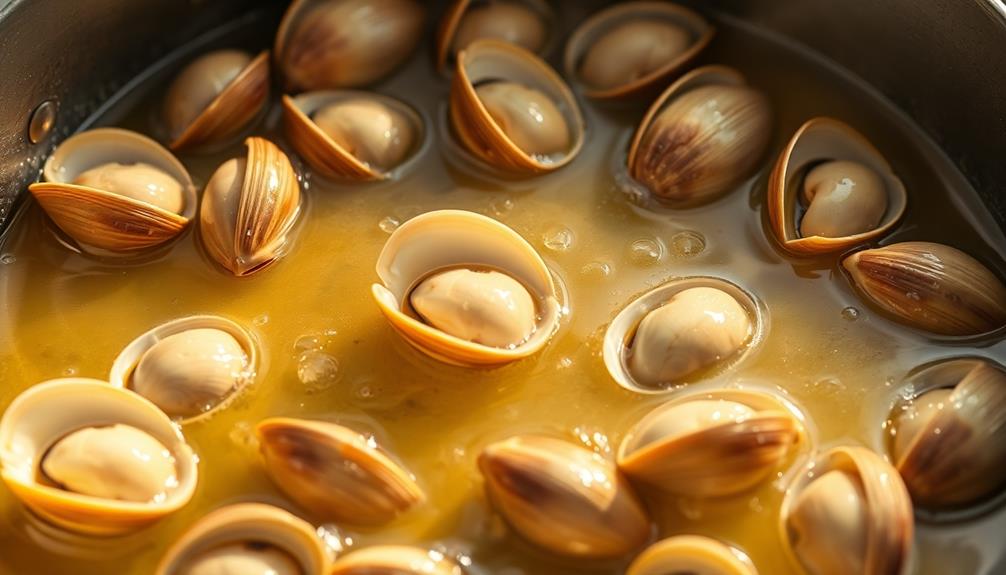
Pouring in the white wine, watch as it simmers and steams, coaxing the clams to open their briny shells. The aromatic liquid combines with the garlicky oil, creating a mouthwatering sauce that clings to the linguine.
Keep a close eye, stirring occasionally, as the clams gradually pop open, releasing their juices into the pan. This is the moment you've been waiting for – when the flavors meld together in perfect harmony.
Once all the clams have opened, about 5-7 minutes, remove any that remain tightly shut. They're not quite ready to join the party.
Adjust the seasoning with a pinch of salt and pepper, then toss the linguine directly into the pan, allowing it to soak up all the delicious juices.
Serve immediately, garnished with a sprinkle of fresh parsley for a vibrant pop of color. Get ready to savor the flavors of the sea in every tantalizing bite.
Final Thoughts
Ultimately, the joy of preparing linguine with clams lies in the balance of flavors and textures that transport you to the coastal regions of Italy. The briny, juicy bites of the clams perfectly complement the tender, twirl-worthy linguine. Each forkful is a delightful symphony, where the garlic, parsley, and white wine harmonize to create a truly memorable dish. Another great accompaniment to linguine with clams is a classic breaded veal cutlet recipe. The crispy, golden exterior of the veal cutlet provides a satisfying contrast to the soft pasta and succulent clams. The flavors of the two dishes complement each other beautifully, making for a truly indulgent and satisfying meal. Whether enjoyed on a special occasion or as a comforting weeknight dinner, this combination is sure to please any Italian food lover.
As you savor the final bites, you'll find yourself daydreaming about your next trip to the Amalfi Coast, imagining yourself dining al fresco with a glass of crisp white wine. The simplicity of this dish belies its ability to evoke such powerful feelings of connection to la dolce vita.
Whether you're feeding a crowd or enjoying a quiet night in, linguine with clams is a timeless classic that will always leave you feeling satisfied and inspired. The only thing left to do is plan your next Italian-themed gathering and share this culinary delight with your loved ones.
Frequently Asked Questions
What Is the Ideal Wine Pairing for Linguine Alle Vongole?
When pairing wine with a dish, you'll want to consider the flavor profile. For a seafood pasta like linguine alle vongole, you'd do well with a crisp, dry white wine that can complement the briny clams and delicate pasta.
Can I Substitute Clams With Mussels or Other Seafood?
You can substitute clams with other types of seafood, like mussels, for your dish. The key is to choose ingredients that complement the flavors and textures of the dish, so it remains balanced and delicious.
How Long Can I Store Leftover Linguine Alle Vongole?
You can store leftover seafood pasta for 3-5 days in the fridge. Ensure it's in an airtight container and reheat thoroughly before consuming. However, the quality and texture may decline after a couple of days.
Is Linguine Alle Vongole Suitable for a Gluten-Free Diet?
Yes, linguine alle vongole can be suitable for a gluten-free diet. You'll need to use gluten-free pasta, but the other ingredients – clams, garlic, white wine, and olive oil – are naturally gluten-free.
What Is the Origin of the Name "Linguine Alle Vongole"?
The name "linguine alle vongole" stems from its ingredients – linguine, a type of long, flat pasta, and vongole, which are small clams. This classic Italian dish originated in the coastal regions, where the fresh seafood was readily available.
